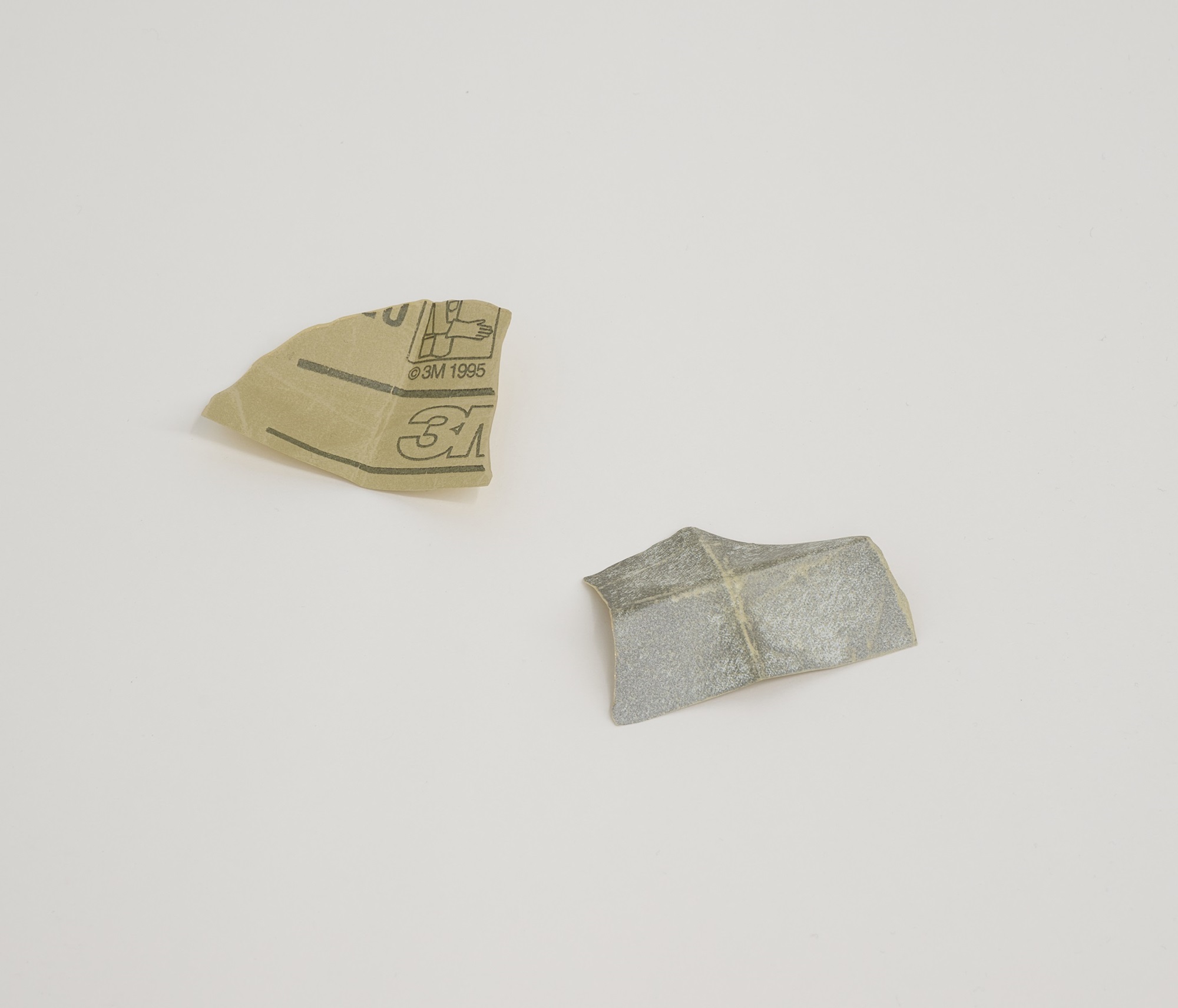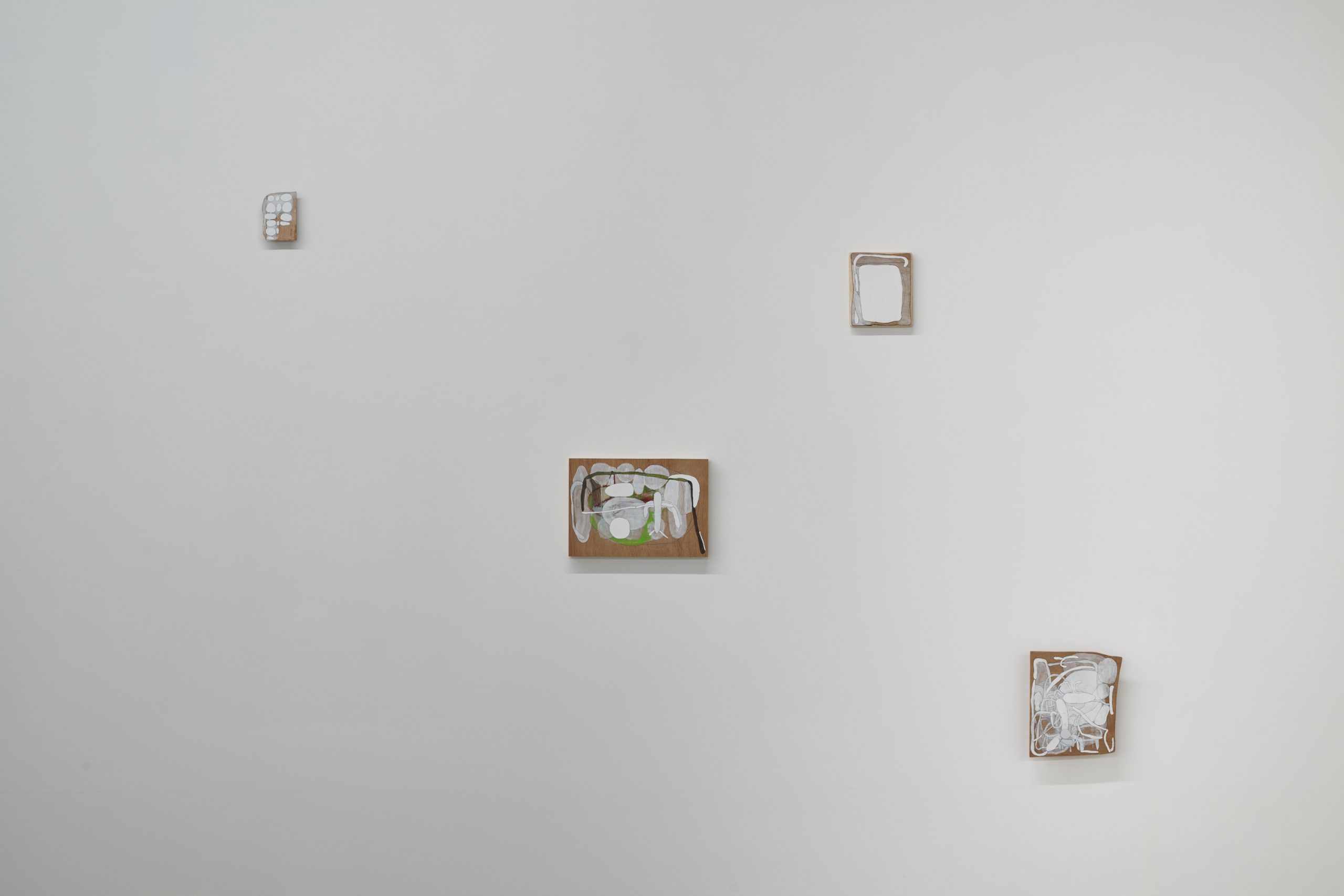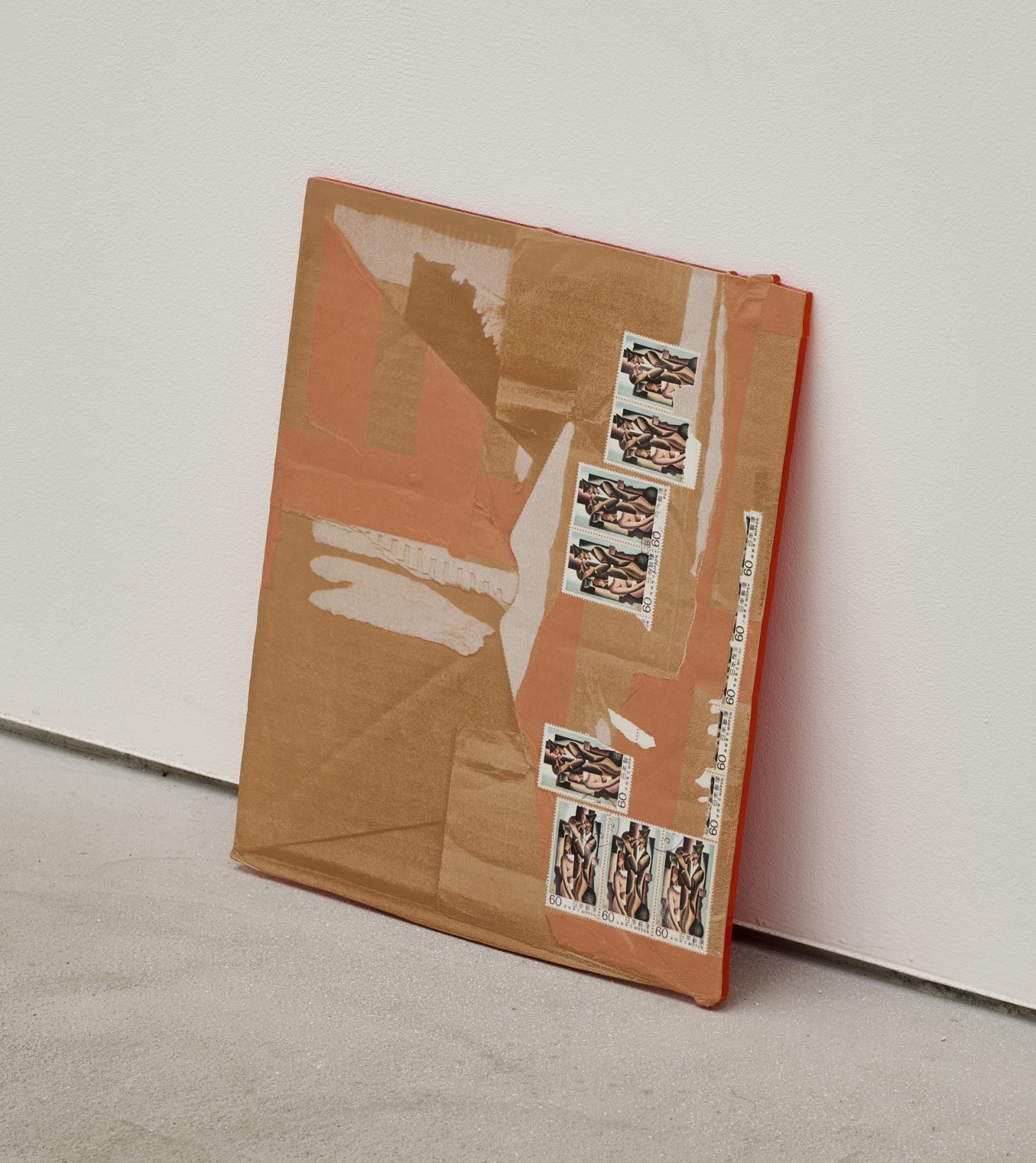News
Patterns and Distance
Makoto Ito, Shoko Masunaga, Kota Sasaki, Nao Osada, Yuka Hotta

Blue sky
2017
Galvanized steel sheet, oil
60 x 72 x 3 cm
Makoto Ito
Ito’s formal yet light-hearted and humorous sculptural works created using diverse materials embody the possibilities of contemporary sculpture.
Blue Sky (produced in 2017) is one of the pieces that draw inspiration from distant scenery visible from a certain location and portray it as something touchable within easy reach. The work uses a photographed bird deterrent attached to a remote power cable as a motif. It expresses the scale of distance as it converts the miniature version of the actual scenery into a sculpture.

Session1
2023
Panel, canvas, acrylic, pencil
38.5 x 46 cm
Shoko Masunaga
With painting as her starting point, Masunaga employs diverse production techniques. Her works, which emphasize their relationships with the surrounding environment and space, possess variable and interchangeable qualities.
Session (produced in 2023) is composed of a combination of several shaped canvases. Their colors, lines, and patterns softly link together, as if the adjacent canvases respond to each other, forging rich relationships.

Untitled
2024
Oil on canvas
33.3 x 24.2 cm
Kota Sasaki
Using 3DCG, Sasaki creates paintings that intersect two and three dimensions through the depiction of spaces such as an atelier or a gallery.
In Untitled, a striped pattern is drawn on a thickly painted canvas. The pattern (two dimensions) is painted onto a rugged-surfaced support structure (three dimensions), creating visual fluctuations caused by different viewing angles. The method produces an illusion of compressed imagery on the canvas, making viewers conscious of the act of seeing.

Surface Preparation (Sandpaper 3M)
2024
Screenprint, brass
each 6.0 x 4.5 x 2.0 cm
Nao Osada
Osada creates works using silkscreen to print the surface elements of a familiar object onto the surface of a material different from that of the original item.
In Surface Preparation (Sandpaper 3M), the images on the front and back of a sandpaper sheet are printed on two identical brass pieces, which can be superimposed on one another. Osada’s works uncover ephemerality in trivial objects discarded in our daily lives and elevate them into something poetic. They inspire humble awareness in viewers, unsettling their sense of reality.

C-144
2024
Acrylic, pencil, gesso, panel
29.7 x 21 x 2 cm
Yuka Hotta
With painting as her starting point, Hotta’s creation is centered around drawings and installations. In her recent works, she has experimented to use diverse media as intermediaries to produce drawings and incorporated printing as a method of expression.
Titled C, the series traces an eyeless exploration depicted using bodily senses. Its free and relaxed strokes rely on animated sensation to render images evocative of breathing.









Nao Osada “Looking around what’s close at hand”

Packing material(Saltimbanque)
2023
Screenprint, UV inkjet print, acrylic
28 x 33 x 0.5 cm

Stained paper cup(Cola)
2023
Screenprint, marble
9 x 11 x 1 cm

Packing material(tape)
2023
Screenprint, UV inkjet print, acrylic
26 x 37 x 0.2 cm

Silica gel and pebbles
2022
Screenprint, UV inkjet print, acrylic, pebble
4.5 x 6.7 x 0.5 cm
Maki Fine Arts is pleased to present Looking around what’s close at hand, a solo show by Nao Osada, starting September 9 through October 8, 2023 at the gallery’s new exhibition space: B1F, 77-5 Tenjin-cho, Shinjuku-ku, Tokyo (located inside the RUSTIC building)
–
A simple overlap
Takuya Nakao, art critic
There is subject a and subject b. Subjects a and b could both be images or they could both be objects. Alternatively, a and b could be an image and an object or an object and an image.
Nao Osada replicates an <image> of the <already existing> by reproducing it onto a photograph, onto a print, and onto the raw material. The <object> that becomes the raw material is also <already existing>. The image of the <already exiting> becomes a coating, and that coating is reproduced onto the raw material. If we treat <image> as a and <object> as b, the transition occurs as <b (already existing) à a (photographed image) à b (coating) à b (support medium)>. In other words, the condition of Osada’s works of <transfer of preexisting image onto support medium> becomes the combination of <coating> as <(object=image+object)> and <support medium> as <+object>, thus becoming <(b=a+b)+b>.
The <image> that is a is <nonexistent>, and the <object> that is b <exists>. In Osada’s works, however, it is important that the <replication> continues—for example, from the <already existing> motif, to the photograph capturing that certain condition, to that material that would be printed upon being ready-made.
a=image [replication]
In a distinction unnoticed by most, two things become identical, and therefore recognized as a replication. Replication places value in sameness, but, invariably, a distinction will emerge, regardless of whether it is noticed or not. The same images that are displayed and duplicated will change into having a characteristic through ownership.
b=object [replication]
Objects are replicated into two- and three-dimensions through <version> or <type>. A <version> of film, data, and silkscreen is printed onto paper, cloth, and other materials, and material becomes a replica through <type>. The replica made through <version> and <type>, however, will contain misalignments and individual variabilities, i.e., stains, smears, wrinkles, or scratches.
These are accounts regarding the general replication of <image> as well as <object>. In Osada’s works, the <image> of the <already existing> and <ready-made goods> is printed (replicated) as <coating>. At the same time, the <object> of the <already existing> and <ready-made goods> becomes the <support medium>. Then, if all these become replica of the <already existing>, <image of replication=a> becomes <object of replication=b> as coating, and doubly overlaps <object of replication=b> that is the support medium. What Osada ultimately ends up creating is, by overlapping a replication on all a and b in <(b=a+b)+b> which equals <(object=image+object) +object>, a condition where these are recognized (viewed) as one that is <already existing>.
Yet, in most cases, the coating and support medium are not combined as one (for example, the image of the corrugated box will not overlap the object of the corrugated box). While some exceptions exist, often, the <image> and <object> individually assert its status as a replication. We must now consider a separate frame that derives from the overlap of replica <image> and replica <object>.
a’=image [readymade]
Readymade was given context in the art world and carries a wide interpretation. Instances of Marcel Duchamp reproducing readymade shadows onto photographs, Andy Warhol reproducing readymade designs onto prints, and Peter Fischli and David Weiss reproducing readymades onto other materials indistinguishable from the original come to mind.
b’=object [readymade]
Readymades themselves have characteristics as individual mediums. Just as a tube of paint placed on canvas becomes a painting or an image transferred on print paper becomes a photograph, an image becomes a piece of work when reproduced onto a different medium or support medium, i.e., paper, cloth, wood, rock, metal, acrylic, mirror, glass, window, a part of a building, etc.
At the overlap of the <already existing> <image> and <object>, an overlap of visual lines occurs between the ready-made goods <a+b> as non-art and the readymade <a’+b’> as art. Therefore, at the overlap of replication called <(b=a+b)+b>, a potential will exist for a frame called <A{(b=a+b)+b}+B{(b’=a’+b’)+b’}> which overlaps <ready-made goods> A=non art and <readymade> B=art.
Osada selects <ready-made goods/readymades> of objects a and b, photographs a, and prints it on b to create a new <image/object>. And most importantly, while that image is used as <ready-made goods/readymades>, it is considered more as one that would be discarded. More precisely, the visual line is cast toward the trace of what would be discarded.
Scattered here and there within the <already existing> images selected by the artist are those that further emphasize the periphery of the replication—for example, those that <envelope>, <support>, or <enveloped>, <supported> the ready-made goods content. In addition, the coating and support medium distinctly overlaps as different mediums. This is when that image of the trace has the appearance of A=non art, yet, in the sense that the selected medium is used as a support medium and reproduced, it reveals the condition of it being B=art. (While the selection of medium is arbitrary, in the sense that it has been deprived of its practicality, artistry in the art world appears.) In this manner, all characteristics including stains, smears, wrinkles, and scratches are moved to the position that overlaps <trace=tache>.
The coating and support medium are united on a <plane>. Its <painting=2D>-like stains and smears and <sculpture=3D>-like wrinkles and scratches remain in 2D instead of becoming 3D. Moreover, they are reproduced onto the support medium as an <illusion> that is <painting-2D>-like in which the 3D-ness has been copied. When this happens, the replication as imitation (mimesis) is the visualization (2D-ness) of the object which reproduces <ready-made goods/readymades> that contains <trace/tache>, as well as being the materialization (3D-ness) of the image by way of being reproduced on a separate medium. In both the day-to-day (life) and the art (production) in which painting- and sculpture-like <contents> are enveloped, supported, and discarded, this work process is made by way of the <already existing> <image> and <object> located at the edge—not at the center but on the periphery. For this reason, by incorporating the <life/production> cycle of daily life into non-art=A as a nested structure, and by not fixing the visualization or materialization of B=art, it can also be returned to A=non-art.
In this manner, Osada’s works rotates non-art and art where the frames of non-art and art for <ready-made goods/readymades> and <A{(b=a+b)+b}+B{(b’=a’+b’)+b’}> overlap: in the way <trace> that is A=non-art becomes B=art, and tache that is B=art becomes A=non-art. The <characteristic of an image as a work of art>—the normal position of <original> and <copy> or <aura> and <non-aura>—and what supports it—<plurality of the support medium as a replicate>—reverses positions. In other words, it becomes <B[A{(b=a+b)+b}+B{(b’=a+b’)+b’}]+A[A{(b=a+b)+b}+B{(b’=a’+b’)+b’}]>. What results is an overlap of conditions providing characteristic to <plurality of the support medium as a replicate> as well as providing plurality to <characteristic of an image as a work of art>. Just like a print misalignment, and just like the individual variabilities found in ready-made goods. There is subject a and subject b; on that simple overlap.
–
Nao Osada
Born 1988, Nao Osada received her MFA from Tokyo University of the Arts.
Notable shows include, The Constitution of Japan (group, MUJIN-TO Production, 2023), Medium and Dimension Liminal (group, Kakinokisou, 2022), At Least One (solo, Maki Fine Arts, 2022), Playground for the Senses (group, ANB Tokyo, 2022), I see (solo, NADiff Window Gallery, 2022).
Nao Osada – 4th PATinKyoto Print Art Triennale in Kyoto 2025
April 15 – May 11, 2025
Kyoto City KYOCERA Museum of Art, Main Building, South Wing 2F
link
Nao Osada “At Least One”

Printed sprayed paints
2022
Screenprint, wood
61 x 49.5 x 17 cm
Maki Fine Arts is pleased to present At Least One, a solo show by Nao Osada, starting Saturday, September 17, through Sunday, November 6, 2022. This is Osada’s second solo exhibition at the gallery since her first show two years ago.
Nao Osada
Born 1988, Nao Osada received her MFA from Tokyo University of the Arts. Notable shows include, I see (solo, NADiff Window Gallery, 2022), (Something) Not Amounting to Much (solo, Maki Fine Arts, 2020), Breathtaking, for a while (solo, Open Letter, 2018), Playground for the Senses (group, ANB Tokyo, 2022), Shibuya Hikarie Contemporary Art Eye Vol.15 (group, Shibuya Hikarie CUBE, 2021), Encounters in Parallel (group, ANB Tokyo, 2021), Alex Dodge, Fuminao Suenaga, Nao Osada by Maki Fine Arts (group, CADAN Yurakucho, 2021), and Sunburn After Swimming in the Painted Pool (group, Tokyo Metropolitan Art Museum Gallery, 2020).
Yasuko Toyoshima, Nao Osada – Medium and Dimention : Maze
7.26 Friday – 9.2 Monday
GASBON METABOLISM (12 Asaoshinden, Akeno-cho, Hokuto-shi, Yamanashi)
Nao Osada “(Something) Not Amounting to Much”

Oshibori(Omotenashi)
2020
Screenprint, glass etching, frame
30.8 x 40 x 2 cm
Maki Fine Arts is pleased to present (Something) Not Amounting to Much, a solo show by Nao Osada, starting Saturday, July 11, 2020. In her first solo show with the gallery, Osada will showcase new works created using silk screen techniques. In these works, surface elements of everyday items such as Amazon shipping boxes and Ziploc freezer bags are printed onto materials, like plywood and acrylic boards, that differ from the original items. With close inspection, subtle differences in texture become apparent, leading viewers into a state of perceptual amazement. Osada’s creative process begins by carefully selecting familiar images from our daily lives and printing them onto various materials, transforming them into delicate objects. Through painstaking experimentation using manual silk screen techniques, the artist has succeeded in harmoniously joining image and material. In contrast to the restrained exterior of her works, the lighthearted and whimsical point of view–demonstrated by what is selected as subject matter–not only adds delight to the viewing experience but also illustrates the distinctive characteristic of Osada’s works. In (Something) Not Amounting to Much, modestly-proportioned new works in the form of wet wipe wrappings, food packaging, and even packaging stickers are scattered throughout the gallery space.
—
In order to be able to explain my work in English, I looked up the meaning of the word ‘trivial.’ Along with synonyms such as ‘minor,’ ‘petty,’ and ‘commonplace,’ I found the description ‘(something) not amounting to much.’ Here I was planning to use the word ‘trivial’ to express my work, yet it was as though the description of the word guessed it right for me instead. My creative process involves facing that ‘something’ even if it doesn’t amount to much.
Nao Osada
—
Nao Osada
Born 1988 in Kanagawa, Japan, Nao Osada received an MFA from Tokyo University of the Arts in 2016. Her recent shows include Outline (group, Maki Fine Arts, 2019), Smooth Accident (group, MA2 Gallery, 2019) and Breathtaking, for a while (solo, Open Letter, 2018). She is scheduled to be part of the upcoming Group Show of Contemporary Artists 2020 at Tokyo Metropolitan Art Museum Gallery A in September, 2020.
“outline” – Dusadee Huntrakul / Amanda Riffo / Manabu Kanai / Nao Osada / Aya Kurashiki

Highway 69
2015
Ceramic
17 x 25 x 17cm
Maki Fine Arts is pleased to present Outline, a five-artist group show, starting Thursday, July 18, 2019. In their first exhibition with Maki Fine Arts, each artist will showcase works that experiment with mediums and examine surface layers, using minimal expression while maintaining independence.
Dusadee Huntrakul was born in Bangkok, Thailand in 1978. He is a graduate of University of California, Los Angeles and University of California, Berkeley. Recent shows include SUNSHOWER Contemporary Art from Southeast Asia 1980s to Now (The National Art Center, Tokyo + Mori Museum, 2017).
Amanda Riffo was born in Paris and currently lives and works in Reykjavík, Iceland. Riffo lived in Tokyo as an artist in residence in 2012 and 2013. Her solo shows include It’s about time (Youkobo Art Space, 2013).
Born 1983 in Tokyo, Japan, Manabu Kanai received his PhD from Tokyo University of the Arts in 2015. He was a visiting researcher at the University of Melbourne from 2015 to 2016. Recent shows include Compiling Behaviors, Digesting Actions (Tokyo Arts and Space Hongo, 2018).
Nao Osada was born in Kanagawa, Japan in 1988 and received her MFA from Tokyo University of the Arts in 2016. Her recent shows include Smooth Accident (group, MA2 Gallery, 2019) and Breathtaking, for a while (solo, Open Letter, 2018).
Born 1993 in Kobe, Japan, Aya Kurashiki completed her MFA in Painting from Kyoto University of Arts and Design in 2018. She is currently pursuing her second master’s degree in Oil Painting at Tokyo University of the Arts. Outline will be Kurashiki’s debut show.

